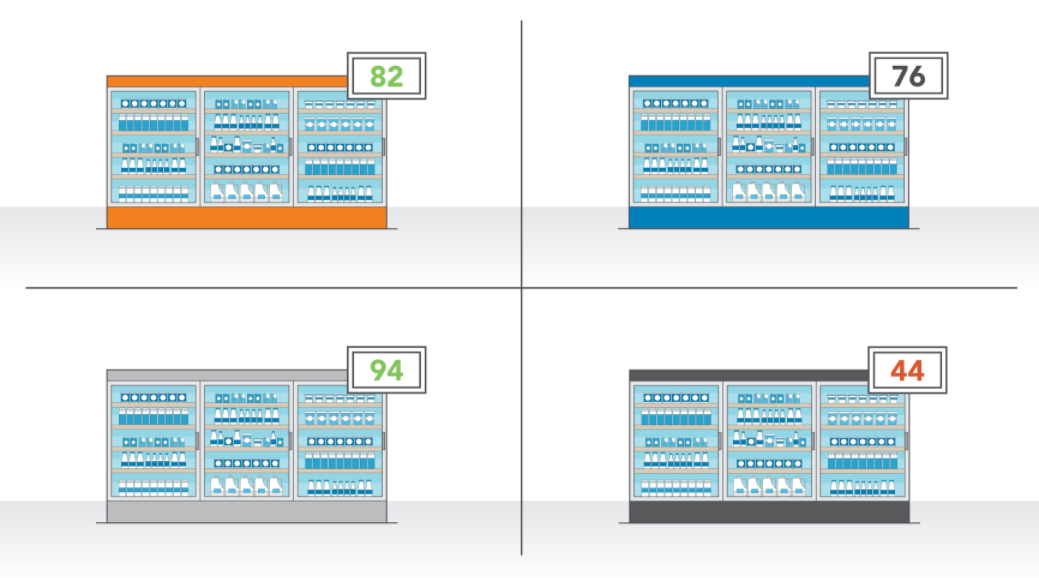You may have seen the term “data-driven” popping up more frequently in the business trade headlines and wondered if it’s just another jargon buzz word. Is the “data-driven” concept really something new? After all, in our age of computers, spreadsheets, market research, and statistics, haven’t industries been driven by data for some time now.
Actually, the term can claim legitimacy when we’re talking specifically about methods for business decision-making. When a company employs a “data-driven” approach, it means that business leadership explicitly wants to use data to drive decisions that are premeditated, planned and objectively evaluated.
Increasingly, leading companies understand that data-driven business decisions stimulate innovation, drive brand value, build market share, optimize operations, improve customer service and increase profits. Yet according to the Harvard Business Review, only 20% of companies are actually empowering their employees with data. That's because a shift to a data-driven strategy cannot succeed without first being nurtured by a data-driven corporate culture. And that culture can only thrive by a top-down commitment starting with the executive leaders.
I’m here to tell you that developing a data-driven culture requires planning, training, and discipline. But that doesn’t mean you have to reinvent your business or replace your team to start seeing the benefits. Following some basic tenets and choosing to work with good data partners will greatly accelerate your progress.
"...a shift to a data driven strategy cannot succeed without being nurtured by a data-driven corporate culture. And that culture can only thrive by a top-down commitment that includes the executive leaders."
Trust the Numbers, Not Your Gut
The primary benefit of a data-driven culture is that it replaces traditional business decision-making processes relying on individual, subjective gut instincts with an objective, logical, and repeatable method applied by all employees across the entire organization. By standardizing and codifying procedures and protocols, decision-making not only becomes more objective but also more robust in lieu of personnel changes or outages (such as a key decision-maker out on leave).
You might be asking, what’s so bad about gut instinct? Maybe your intuitive hunches served you well in the past. Maybe there were times when your gut instinct was a good predictor of strategic next steps, especially if your intuition was based on previous good decisions you made in the past.
But here’s the issue: did you know for sure that your “right decision” wasn’t merely a lucky guess? Was there anything concrete you could point to that grounded your decision in any way that could be measured? Would you be able to document how you arrived at your decision so that it could be modeled into a best practice that other team members can reproduce?
If you look closely at your current business practices, you may find you are more data driven then you realize. The data that you now rely on is most likely informing real-world decisions that may not seem consciously data-driven when you made them.
For example, here at SmartSense, we monitor refrigeration equipment performance for our customers. Given that we’re gathering millions of data points about reliability, make, and model, our customers need not trust only their subjective impressions of dependability. Instead, they have empirical evidence pointing precisely to which equipment is the best long-term investment.

The challenge of gut instinct is that intuitive decisions are subconsciously biased by moods, personal feelings, and irrational assumptions all people are prone to. As an illustration, let’s say that Brand X’s equipment fails twice as often as other brands. Because of the well-known phenomenon of “cognitive recency bias,” your gut tells you that Brand X is unreliable. But when viewed in aggregate in comparison to other brands, Brand X is actually more reliable. It might well be that, because you have five times as much Brand X equipment than any other, you should expect more failures to occur with that brand.
What it comes down to is this: you don't want a subjective frame of mind to be a prime influencer in any decision-making process. Because then you’re tying the future success of your business to a decision that ends up significantly impacted by spurious factors (like whether you missed lunch and are hungry). What you do want is a standardized decision-making process using specific data sets and metrics that can be used reliably and consistently to assess business assumptions and predictions.
Consider how many similar decisions you make every week. How would you approach them differently if you have standard set of data that you and your team trusted? A data-driven approach may not be perfectly accurate, but it’s always the most objective method for gauging the truth about business conditions. Otherwise, by ignoring the statistical evidence, you may be making key decisions simply by chance. Would you bet on your future on a roll of the dice?
Grow Your Data Culture from the Top Down
A data-driven corporate culture rarely grows up using a grass roots approach, meaning from the bottom up. Rather, the business leaders need to support the idea, evangelizing at the very top, spreading the concept through management and ultimately to the rest of the organization.

In short, the leadership must make it a priority for the company that all decisions should be anchored in data. This is not to say that a single business unit couldn’t implement their own data-driven culture. Certainly, that’s a step in the right direction. But the greatest benefits occur when a data-driven program is implemented companywide.
A CEO can promote this shift through example, by practicing new habits and creating expectations. For example, after SmartSense consolidated its purchase of several other temperature monitoring companies, the new organization continued processing and measuring data according to the different methods each company had used in the past (in effect, creating data silos).
Kevin Riley, our President, accelerated an initiative to replace these various methods with a single data system. By streamlining and realigning, each unit was able to work toward meeting a single set of performance metrics that would measure success as a singular brand.
Once the business unit leader or CEO chooses a data-driven mission, it must be clearly communicated and understood by top-level executives. From there, management provides training and resources to department teams to help make them comfortable with numbers and confidant about analyzing and interpreting their own data. When that happens, buy-in occurs, and a data-driven culture takes root and grows.
Be F.A.I.R
Transitioning to a data-driven culture can be a bumpy road if the organization historically has been in the habit of conducting business routines for long periods without change. One best practice to conceptualize a good working relationship between employees and data is the FAIR guiding principles for data:
• Findable: Data should be easy to find for both humans and computers.
• Accessible: Once users find the required data, they need to know how it can be accessed, including authentication and authorization.
• Interoperable: The data needs to be integrated and interact with applications or workflows for analysis, storage, and processing.
• Reusable: Data should be well-described so that it can be replicated and combined in different settings.
Typically, the two primary obstacles you may run up against are data silos and lack of technical standards. Data silos are created when different departments within the organization, such as customer service, marketing, and strategy, store and maintain their data sets separately, with little to no overlap. On top of that, the "owners" of these silos don't always "play nice" with each other, instead thinking of their data as their own turf or fiefdom.
When silos occur, business leaders need to make clear that sharing data and making it easily accessible is an asset that allows everyone across the company to do their jobs better. They must discourage managers from data hoarding or putting up barriers to gathering data when and where it's needed.
An important way to make data more usable is to ensure everyone in the company is speaking the same language. Often, different departments use different vocabularies to refer to the same thing (e.g. “clients” are referred to as “customers” by customer service, “targets” by marketing, and “regions” by strategy), or use the same term to refer to different things ( e.g., “group” to mean “customers,” “users” or “distribution partners”). Managers must be willing to re-align terms and naming conventions to prevent confusion and encourage clear understanding and communication.
Another challenge concerns lack of technical standards. Data can come from a variety of sources and be stored in different formats, especially if siloed. The time may come when it's wise to invest in central data storage and distribution.
Centralizing data removes many of the reasons technical issues come up in the first place by streamlining different management styles, maintenance procedures, tools and providers into a single system. A single system reduces friction, making it easier for shared data concepts to actually work properly, thereby improving the chances that your company will become successfully data-driven.
Good Data In, Good Decisions Out
Comprehending all of these challenges to manage and manipulate data is often referred to as “data literacy.” That simply means having the depth of knowledge to understand any data set’s statistical significance, its validity and accuracy, its implications and impact. And what matters the most is interpreting how your company’s internal data should be integrated with external industry and market data to make key business decisions.
For example, here at SmartSense, we know Pfizer and Moderna have received FDA approval of their COVID-19 vaccines and need to distribute them nationwide safely and effectively at specific temperatures to ensure efficacy and safety.
Our customers leverage our solution to monitor these vaccines in storage at their sites before they are administered. This option works great when the power is on and all equipment is functioning property. But what about situations that put equipment at risk?
For instance, many of our customers are national pharmacy chains located across North America. From blizzards to hurricanes, they are all susceptible to unpredictable weather events that cause power outages taking sites offline for hours or days at a time.
Our solution then goes beyond typical alarming protocols and takes command to save temperature-sensitive vaccines and medicines. Store operators leverage our data collection to identify equipment with the highest risk of exceeding minimum safe temperatures.
In the event of a complete communication black out, they review the historical data logged during the outage. This information tells them exactly what inventory has likely undergone a temperature excursion. Prior to this capability, management would have had no choice but to destroy the entire inventory.
To maximize the value of this information, managers must be “data literate.” That means they understand the unique lens of conditions and can answer key questions with confidence and expertise: Is this the right data? Is this the best data? Is the data accurate? Has the data been processed correctly? Most important, can executive management and the CEO use the data to make good decisions?
No matter how data-driven the organization might be in theory, if in practice the data is bad, the CEO is likely to make a bad decision. As the saying goes, "garbage in, garbage out." That's why it should be a top priority to build your internal data capability. And the best and fastest way is to train a team or hire a leader who can integrate, analyze and interpret internal and external data in a practical way that can be translated into concrete business strategies and best practices.
This post is related to:
Temperature Monitoring (Wireless)